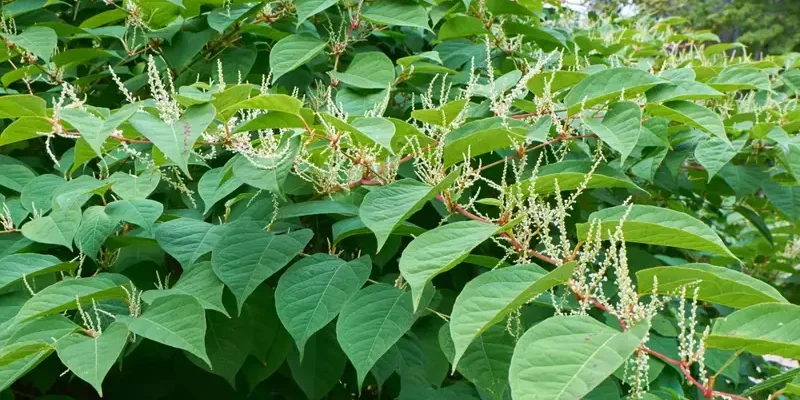
Imagine having an invasive plant that gradually overpowers the whole garden. Japanese knotweed can cause serious damage to your garden and infrastructure, not to mention its dire environmental effects. So you need to ensure that it’s properly eradicated.
In this article, you’ll learn how to spot and remove Japanese knotweed permanently.
Identifying Japanese Knotweed
This sneaky plant has uncanny similarities with about 17 other plants. As an example, most people can hardly differentiate it from Russian vine or Himalayan honeysuckle.
If Japanese knotweed appears in your garden, you should know how to spot it.
Physical Characteristics
You need to look for attributes that make this weed recognisable without a shred of a doubt. Over time, you’d notice them in the middle of a forest.
Stems
This weed is nicknamed bamboo weed because of its similarities with the original plant. Japanese knotweed stems are bright green, but they have purple specks that differentiate it a little from bamboo.
The stems are hollow from the inside, they’re segmented, and they have nodes at regular intervals. This plant can reach unusual heights of around 300 cm in a single season, which is pretty impressive.
Leaves
If you need a key identifier for knotweed, look no further than its foliage. A large heart-shaped leaf is a giveaway. In spring, it gets a reddish tinge before turning deep green.
The leaves are usually sizable, with lengths reaching up to 15 cm. They grow in a zigzag pattern, alternating along the length of the stem.
Flowers
Japanese knotweed produces white clusters of florets that look surprisingly lovely. This is one of the reasons why this plant was imported from its native lands in Asia.
The flowers first appear in late summer, spread throughout spring, and persist till early autumn. The clusters start small, and then they grow into long upright racemes.
Rhizomes
These underground structures are also quite similar in bamboo and knotweed, but there’s a way to tell them apart. Once they’re cut open, knotweed rhizomes reveal a distinctive orange colour.
Growth Patterns
Japanese knotweed is notorious for growing quickly and aggressively. Its peak growing season is during the hot summer months. That’s when its stems grow 10 centimetres or more each day.
This plant follows a strict seasonal agenda starting in spring, as its purple shoots emerge from the ground. They quickly develop into vigorous green stems. By summertime, it reaches full height and gets full foliage.
The cycle of growth reverses in autumn. The leaves gradually turn yellow, and then fall off. In winter, knotweed appears to be dead. Its stems become brown and dry, but they stand in their place, waiting for the circumstances to become favourable again.
Japanese knotweed is a trickster. Above the ground, it can seem fragile and dead. On the other hand, its rhizomes remain viable, with networks extending 3 metres deep and 7 metres all around.
Locations
This weed is highly adaptable, so you can find Japanese knotweed in various settings. Here are some examples:
- Urban gardens and parks. Despite the consistent efforts of park administrators and homeowners, Japanese knotweed still manages to make an appearance in these managed landscapes. It often comes from contaminated soil or spills over from neighbouring properties.
- Along railways and roadsides. Knotweed spreads efficiently in places where its seeds and fragments can be carried around by moving vehicles.
- Around water bodies. Like most plants, Japanese knotweed is fond of rivers, streams, lakes, and canals. Moving water is particularly useful for this weed, as it carries its fragments downstream to new colonies.
- Construction sites. If the building equipment is contaminated with knotweed parts, they’ll infect the unused land with that plant.
- Neglected or abandoned areas. Weeds generally thrive in brownfield sites and waste collection areas. They provide the perfect conditions for knotweed to thrive and spread itself unchecked.
Understanding the Dangers of Japanese Knotweed
Weeds often appear harmless and pretty, until their aggressive nature comes out. Japanese knotweed is an environmental threat, and it poses significant risks to the infrastructure. Some legal matters could ensue as well.
Thus, it’s important to be aware of these dangers.
Property Damage
Foundation damage comes at the top of the risks. This plant’s elaborate rhizome network takes advantage of the tiniest cracks in concrete. It gradually widens these microfractures, which could eventually affect the building’s integrity.
This can decrease the property’s value by up to 10%. It could also cause mortgage issues, as lenders are rightfully reluctant to invest in weed-infested houses.
Environmental Impact
The loss of biodiversity is a scary prospect, and it’s a real concern with this plant’s hostile growth pattern. It outcompetes the native species, which has ecological consequences. The reduction in local plant diversity, in turn, affects the animals, birds, and insects in that area.
Japanese knotweed can increase soil erosion, especially during the winter’s heavy showers. When its foliage dries up, it leaves the ground exposed to the elements.
This plant grows densely in rivers and waterways, blocking their natural flow. The accumulated water can eventually overflow, creating massive floods.
Legal Implications
This plant can degrade infrastructure and affect biodiversity, so it’s serious enough to warrant regulatory mandates.
If you have Japanese knotweed on your grounds, that’s annoying, but it’s not a legal transgression. Spreading it is a problem though. Disregarding this requirement could result in a community protection notice or an anti-social behaviour order.
There’s more. If you cut or uproot this weed, you’d have to treat it as controlled waste. According to the Environmental Protection Act of 1990, it should be disposed of in licensed landfill sites.
Legal matters don’t end with spreading or disposing of Japanese knotweed. Homeowners planning to sell their property are bound by law to disclose that matter. Failure to do so can result in legal action, as the buyer would have to spend time, money, and effort to deal with the weed issue.
Finally, Schedule 9 of the Wildlife and Countryside Act states that it’s an offence to grow Japanese knotweed in the wild.
Removing Japanese Knotweed
Now that’s a challenging task! One that requires tons of patience and often a combination of methods. Complete eradication is rather difficult, but using the right approach can limit its spread.
Mechanical Methods
This plant can regrow from the tiniest fragment, so be careful while removing it. Taking out the stem is easy, but digging out the rhizomes is another matter. You need to dig 7 metres deep and 3 metres wide from any visible growth to be sure you’re uprooting the whole Hydra.
Successive, repeated cutting is another method to weaken these weeds until the rhizomes give up and stop spreading left and right. This wouldn’t obliterate the weed, but it’s sufficient to rein it in.
Additionally, all of the excavated or cut material has to go directly to a licensed landfill site.
Herbicides
Chemical methods often give the best results. To that end, most commercial and residential settings favour glyphosate-based herbicides. These substances are systemic, meaning that the leaves absorb the inhibitive material and transport it to the rhizomes.
Japanese knotweed is highly active from late spring to early autumn and takes in any nutrients it can find. Therefore, that’s the best time for herbicide application. It often takes 3-5 years of consistent treatment every season to fully control an infestation.
Smothering or Solarisation
Depriving any plant of light eventually weakens it. This method starts with covering the entire infected area with black plastic sheeting. Make sure that there are no tears and that the covering extends well beyond the weed’s territory.
The cover must stay intact for about three years to smother the weed sufficiently and render it inactive. For better results, you can spray it with a suitable herbicide and excavate the plot.
When to Call Professional Gardening Services
Property owners can handle some aspects of Japanese knotweed management. However, there are times when professional gardeners aren’t just beneficial, but necessary.
Consider bringing in a specialist if you’re dealing with any of the following situations.
- The weeds are well-established and widespread;
- You’re unsure about identifying the plant;
- Removing the knotweed seems like a daunting task;
- There’s plenty of weed around the building, so the foundations might be affected;
- You need to have formal documents certifying that your property is compliant with weed removal regulations;
- The new tenant or property owner wants a guarantee that knotweed wouldn’t regrow, or that it wouldn’t incur extra expenses.
Conclusion About Dealing With Japanese Knotweed
Japanese knotweed is indeed a sneaky plant that creeps up on your beautiful garden, but it’s not the end of the world. Having learned how to identify and eradicate it, you can rest assured your garden is in safe hands.
So, wear your gloves and grab your shovel. It’s digging time!










